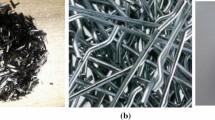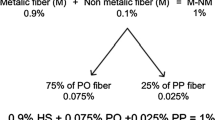Abstract
The structural response of prisms of cross section 100×100 mm and length of 500 mm constructed with reinforced fibrous concrete and subjected to pure tensile loading has been presented in this contribution. The main focus was to study the effects of adding different metallic fibers in mono and hybrid form in the conventionally reinforced concrete on the tension stiffening and strain development. Two metallic fibers with different geometrical, mechanical and physical properties were investigated: amorphous metallic straight fibers and carbon steel hooked-end fibers. A total of four concrete mixtures: control, single fiber and hybrid fiber reinforced concretes were prepared. The fibers were investigated at content of 20 kg/m3 for single fiber reinforced concretes, and for hybrid fiber reinforced concrete, at content of 40 kg/m3. Through studying load-deformation response of composites and strain development in steel bar and concrete, it has been found that the metallic fibers improve tension stiffening effect and influence significantly the strain development. The effect of two metallic fibers on tension stiffening was seen to be different at different loading stages. On the other hand, when fibers were used in hybrid form, the behaviour of the composite was improved at all loading stages in terms of tension stiffening and resistance to cracking.
Similar content being viewed by others
References
Abrishami, H. H. and Mitchell, D. (1997). “Influence of steel fibers on tension stiffening.” ACI Structural Journal, Vol. 94, No. 6, pp. 769–182.
ACI 224.2R-92 (1997). Cracking of concrete members in direct tension.
Bischoff, P. H. (2003). “Tension stiffening and cracking of steel fiberreinforced concrete.” Journal of Materials in Civil Engineering, Vol. 15, No. 2, pp. 174–182.
Banthia, N. and Nandakumar, N. (2003). “Crack growth resistance of hybrid fiber reinforced cement composites.” Cement & Concrete Composites, Vol. 25, No. 1, pp. 3–9.
Christiansen, M. B. and Nielsen, M. P. (2001). “Plane stress tension stiffening effects in reinforced concrete.” Magazine of Concrete Research, Vol. 53, No. 6, pp. 357–365.
Fields, K. and Bischoff, P. H. (2004). “Tension stiffening and cracking of high strength reinforced concrete tension members.” ACI Structural Journal, Vol. 101, No. 4, pp. 447–456.
Ficher, G. and Li Victor, C. (2002). “Influence of matrix ductility on tension-stiffening behaviour of steel reinforced Engineered Cementitious Composites (ECC).” ACI Structural Journal, Vol. 99, No. 1, pp. 104–111.
Kianoush, M. R., Acarcan, M., and Ziari, A. (2008). “Behaviour of base restrained reinforced concrete walls under volumetric change.” J. Eng. Struct., Vol. 30, No. 6, pp. 1526–1534.
Mindess, S. (1995). Fiber reinforced concrete: Challenges and prospects, Fiber Reinforced Concrete, by Banthia, N. and Mindess, S. (ed.), Second University-Industry Workshop on Fiber Reinforced Concrete and other Advanced Composites, Toronto, Canada.
Mohammadi, Y., Singh S. P., and Kaushik, S. K. (2008). “Properties of steel fibrous concrete containing mixed fibres in fresh and hardened state.” Construction and Building Materials, Vol. 22, No. 5, pp. 956–965.
Prakhya, G. K. V. and Morely, C. T. (1990). “Tension-stiffening and moment-curvature relationship of reinforced concrete elements.” ACI Structural Journal, Vol. 87, No. 5, pp. 597–605.
Redon, C. and Chermant, J.-L. (1999). “Damage mechanics applied to concrete reinforced with amorphous cast iron fibers, concrete subjected to compression.” Cement and Concrete Research, Vol. 21, No. 3, pp. 197–204.
Swaddiwudhipong, S. and Seow, P. E. C. (2006). “Modelling of steel fiber-reinforced concrete under multi-axial loads.” Cement and Concrete Research, Vol, 36,Issue 7, pp. 1354–1361.
Turatsinze, A. and Bascoul, A. (1996). “Restrained crack widening in mode I crack propagation for mortar and concrete.” Advanced Cement Based Materials, Vol. 4, Nos. 3–4, pp. 77–92.
Author information
Authors and Affiliations
Corresponding author
Rights and permissions
About this article
Cite this article
Hameed, R., Turatsinze, A., Duprat, F. et al. A study on the reinforced fibrous concrete elements subjected to uniaxial tensile loading. KSCE J Civ Eng 14, 547–556 (2010). https://doi.org/10.1007/s12205-010-0547-0
Received:
Revised:
Accepted:
Published:
Issue Date:
DOI: https://doi.org/10.1007/s12205-010-0547-0




